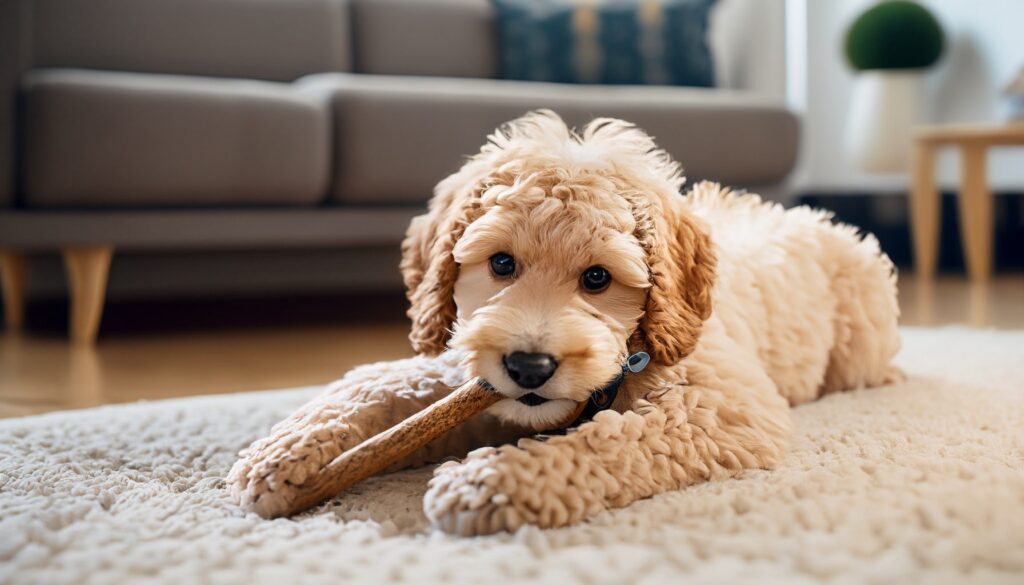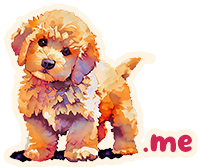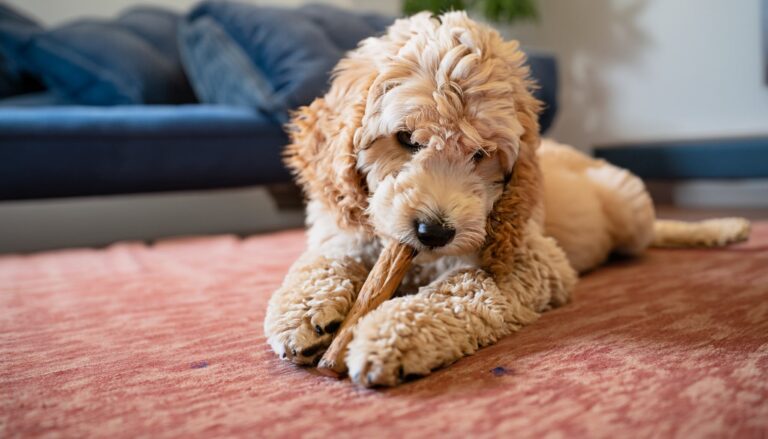Chews are quite necessary when raising a puppy, so they can relieve their urge to chew while they are young and curious, and also as their adult teeth come in! It is always a good idea to have a plethora of edible and inedible chews on hand. This comprehensive list has been developed (and continues to be revised and added to) by our CO-OP breeders. If you have something you would like to add, we encourage you to submit a suggestion on Social Media.

Edible Chews
Edible Chew Guidelines:
- How often should you give edible chews? Treats should not make up more than 15% of a dog’s caloric intake. A generally rule of thumb is no more than 1 edible chew a day.
- If an edible chew is interfering with your puppy’s appetite so much that they are not eating the recommended amount of nutrient-formulated kibble each day, it is best to reserve edible chews to every-other-day treats, or utilize low-calorie edible chews.
- If your puppy is consuming chews too quickly, take the edible chew away after 15-20 minutes and exchange it for an inedible chew, or enrichment toy. Or consider taking them outside for some exercise and play, then returning to the chew/enrichment to unwind afterwards.
- Please supervise your puppy when they are chewing on any object.
- If an edible chew is causing diarrhea, vomiting, broken teeth, coughing, or gas- discontinue use. and consult your veterinarian. If your puppy is exhibiting symptoms of an obstruction– call a vet or take them to an ER vet immediately.
- Do not let your puppy chew on sticks or rocks.
- Do not feed a dog or puppy cooked bones, as they can splinter in the stomach and liver, causing health problems.
Edible Chew Recommendations:
- Buffalo Tendon (on Amazon)
- Buffalo Ears (on Amazon)
- Buffalo Lung (on Amazon)
- Beef Esophagus/Gullet (on Amazon)
- Beef Cheek Roll (on Amazon)
- Pork Chomps Munchie Sticks (on Amazon, in store at Petsmart)
- Thin Bully Sticks (on Amazon, in store at Costco, Petsmart, Petco, and Walmart)
Thick Bully Sticks (on Amazon, in store at Costco, Petsmart, Petco, and Walmart)
Low-Calories Chew Options:
- Frozen Whole Fruits and Vegetables make excellent low-calorie chews 🥕🥒🍎🍌🍉🍈 (the coldness soothes discomfort caused incoming adult teeth).
- Dog-Safe Fruits & Vegetables (your dog has unique likes and dislikes, so some items on the list may not be to their tastes!😅)
- Carrots
- Cucumber
- Cooked Whole Sweet potato
- Apple with Core & Seeds Removed
- Peeled Banana (whole or cut down the center)
- Peeled Cantaloupe Slices
- Peeled Watermelon Slices
- Peeled Honey Dew Melon Slices
- Asparagus
- Celery
- Dog-Safe Fruits & Vegetables (your dog has unique likes and dislikes, so some items on the list may not be to their tastes!😅)
- Dried Sweet Potato Jerky (on Amazon)
- Kongs filled with Puree or Bone Broth and Frozen (The kong-toy can be purchased in store at Petsmart, Petco, Walmart, or online Chewy or Amazon) what you fill the kong with should be a puree of (dog-safe) fruits and vegetables, and/or unseasoned cooked meat. Alternatively you can plug the bottom of the Kong with a puree and fill the rest with sodium-free unseasoned bone broth or plain greek yogurt.
Inedible Chews

Inedible chews last much longer than edible chews, and are more effective at cleaning a dog’s teeth of plaque and keeping them busy without affecting appetite. It is still important to supervise your pet with these chews. Inedible chews are durable, but have been known to cause tooth breakage. That is not typical, but is still something to look out for with these types of chews (as well as ingestion, choking, and obstruction). Just be careful and observant with your puppy.
Inedible Chew Guidelines:
- Always pickup inedible chews and place them in a safe place out of reach. Not only is it for the safety of your dog, but doing this will create a sense of reward when the chew is reintroduced to them again. Inedible chews, if left around the house or accessible in a toy box will lose their value to a dog. Putting toys out of rotation for a time, will make them more exciting and valuable to the dog when reintroduced!
- Mix up the types of inedible chews you give your dog. From shape, to flavor, to texture.
- Keep a close eye on their teeth (important for heavy chewers!)
- Throw out the toy if pieces are breaking off or it has become sharp to the touch (due to teeth impressions).
Inedible Chew Recommendations
- Nylabones
- Benebones
- Lumabones
- Hooves, Uncooked Boned (do not ever give a dog cooked bones), and Antlers. Please read the note below for these chews.)
- NOTE: You must watch your dog carefully with Hooves, Antlers, Horns, or Raw Bones. These chews are the most common items to break a tooth, which is very painful. We do not recommend or provide these items with our puppies, but have heard from owners who utilize them without issues. A good rule of thumb when using these strong chews keen supervision during use and to put the item away after a short duration of time. Just because these chews are strong, does not mean they are ideal for super-chewers. A super chew obsessive dog will put more pressure on their teeth when chewing, and with a chew as strong as these- that pressure will increase the risk of tooth breakage! Be careful.

